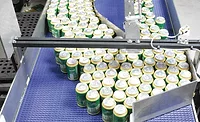Craft brewer improves kettle-cleaning process
Ocelot Brewing uses two-step approach to dissolve brewing buildup

Cleaning beer stone and wort residue is pretty much the same song but a different verse for many craft brewers, but Mike McCarthy and the team at Ocelot Brewing are humming a different tune. The two-year-old taproom in Sterling, Va., brewed 1,500 barrels of beer in 2016, but you’d never know it by looking at their brewing kettles — they look brand new.
They like big beers and they cannot lie
Ocelot emerged from a combined passion for beer and music, and, to this day, all of its beer — whether the IPAs, sours or saisons — are named after song titles. The company itself is named after a Phish song, and the tap list on any given day will tingle your taste buds and your ears.
Ocelot operates out of a 15-barrel brewhouse with six 30-barrel fermenters. The taproom accounts for about 70 percent of its business, but Ocelot also is distributed locally across northern Virginia and the Washington, D.C., area.
The (kettle cleaning) ‘Stairway to Heaven’
The outcome is undoubtedly delicious, but the brewing process is messy. After boiling grain, wort and hops for long stretches of time, the kettles get stained with deposits of beer stone, wort extract, hop lipids and more. Whether steam jackets or open flame, the build-up is most prevalent around the heat source.
The deposits have to be thoroughly removed so that the buildup doesn’t fall into the kettle or impede the heating and temperature buildup in the kettle. Most brewers turn to caustic chemicals and peroxide additives and still have to manually scrub kettle walls — a time-consuming and labor-intensive chore, until one master brewer found a better way.
Steve Gerloff, a master brewer and technical sales representative for Madison Chemical, devised a two-step approach to dissolve brewing buildup. First, a specially inhibited acid formulation called Compound LD5 is introduced into a tank. Used at a dilution of 1 to 2 percent, depending on soil loading and cleaning frequency, the LD5 removes the crystalline structure of the scale by dissolving the carbonate bond within the scale deposit through a thermodynamic reaction. The acid cycle lasts for 15 to 45 minutes at 155 degrees Fahrenheit, and the brewer can “set it and forget it” while the LD5 does the scouring.
Once the LD5 is drained and the kettle has been rinsed, the second cycle begins. For this step, the brewer uses a 1 to 2 percent diluted solution of Enviro-Clean Boil Out, a specially formulated alkaline specifically designed for hot-side brewery cleaning.
‘All You Need is Love’ (and beer)
McCarthy still has nightmares about cleaning kettles in the good old days, before he learned about the LD5/Boil Out combination. Despite scrubbing with brushes or using caustic chemicals, like a professional brewers wash, malt stains proved stubborn — but not anymore.
The two-step cleaning process delivers a double whammy. First, the LD5 treats the malt stains and breaks down the crystallization on the stainless steel. Then, the Boil Out delivers a knockout punch, rinsing away any leftover stains without additional scrubbing.
When it came time to decide how Ocelot was going to clean its kettles, McCarthy had an easy solution. After brewing for a larger operation, which produces 15,000 to 20,000 barrels a year with kettles running around the clock, McCarthy knew the process would work on a smaller scale.
“We’re much smaller, so the kettles aren’t even as dirty. The process works like a charm,” he said.
McCarthy noted that switching to the two-step process wasn’t a time-saving measure, but rather a labor-saving one. Running two 30-minute cycles isn’t any faster than running a 30-minute cycle and then scrubbing the kettle for 30 minutes. By making the Boil Out do the heavy lifting in that second cycle, McCarthy and his team can be doing something more productive like attending to other cleaning cycles.
“We don’t run six days a week like other larger breweries, but still, we appreciate the labor savings. We’re certainly more productive by doing something else while the process is running unattended,” he said.
Even in a smaller craft-brewing environment, the kettles have to be cleaned. By using the two-stage process, McCarthy and his team let the chemicals do the scouring, saving valuable manpower for more important things, like brainstorming music-related titles for the brewery’s next batch. BI
Looking for a reprint of this article?
From high-res PDFs to custom plaques, order your copy today!




